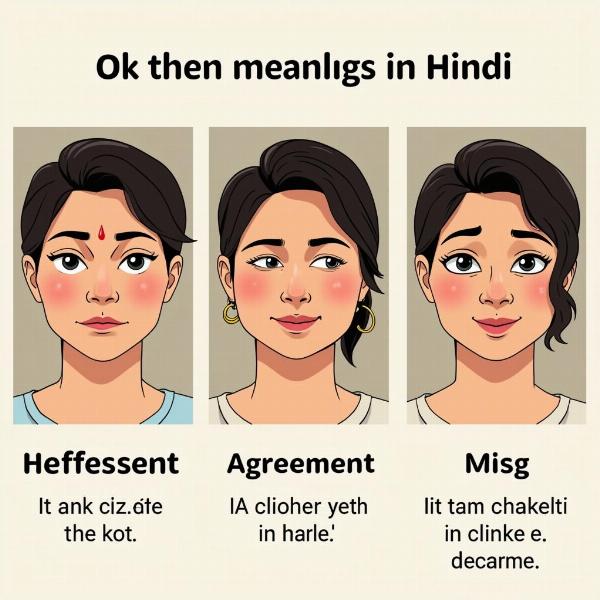“Ok then” is a common phrase in English, often used to acknowledge a statement, indicate agreement, or signal a transition in conversation. But what does it mean in Hindi, and how do you use it correctly? This article explores the various Hindi translations of “ok then,” delving into their nuances and cultural context to help you communicate effectively in Hindi.
Various Hindi Translations of “Ok Then”
The meaning of “ok then” in Hindi can vary depending on the context and the tone of voice used. Here are some common translations and their usage:
- ठीक है फिर (Thiik hai phir): This is the most direct translation and is generally suitable for most situations. It carries a neutral tone and simply acknowledges the previous statement.
- अच्छा ठीक है (Achchha thiik hai): This adds a touch of politeness and agreement. “Achchha” softens the phrase and makes it sound more friendly.
- चलो फिर (Chalo phir): This implies a sense of moving forward or proceeding with something. It’s often used to conclude a discussion and initiate action.
- तो ठीक है (To thiik hai): This version emphasizes the “then” aspect of “ok then.” It suggests acceptance of a situation or a decision.
Understanding the Context
Just like in English, the meaning of “ok then” in Hindi can change based on the context. For example, “ok then” can express resignation, agreement, or even a hint of sarcasm depending on the situation.
- Agreement: “If you think that’s best, ok then.” (अगर आपको लगता है कि यह सबसे अच्छा है, तो ठीक है – Agar aapko lagta hai ki yah sabse achchha hai, to thiik hai.)
- Resignation: “Ok then, I’ll do it myself.” (ठीक है फिर, मैं खुद कर लूँगा – Thiik hai phir, main khud kar loonga.)
- Transition: “Ok then, let’s move on to the next topic.” (चलो फिर, अगले विषय पर चलते हैं – Chalo phir, agle vishay par chalte hain.)
 Ok Then in Hindi Expressions
Ok Then in Hindi Expressions
Cultural Considerations
While the direct translations are often sufficient, understanding the cultural context can help you use these phrases more naturally. Indians often use indirect language and avoid direct confrontation. Therefore, “ok then” might sometimes be used to politely disagree or express hesitation.
Using “Ok Then” in Different Scenarios
Here are some examples of how to use “ok then” in different scenarios:
- Formal situations: Stick to “ठीक है फिर (Thiik hai phir)” or “अच्छा ठीक है (Achchha thiik hai)” to maintain a professional tone.
- Informal conversations: You can use any of the translations, depending on the nuance you want to convey.
- Written communication: “ठीक है फिर (Thiik hai phir)” is usually the most appropriate choice.
How do you say “ok then” in a slightly annoyed tone in Hindi?
You could use “ठीक है ना (Thiik hai na)” with a slightly raised intonation to convey mild annoyance.
What is a formal way to say “ok then” in Hindi?
“ठीक है फिर (Thiik hai phir)” is a safe and formal option.
Conclusion: Choosing the Right Phrase
Understanding the nuances of “ok then” in Hindi can significantly improve your communication. By considering the context, tone, and cultural implications, you can choose the most appropriate phrase and convey your intended meaning effectively. “Ok then” might seem simple, but its meaning in Hindi can be multifaceted. Mastering these subtle differences will help you navigate conversations with greater ease and cultural sensitivity.
FAQ:
- What is the most common way to say “ok then” in Hindi? The most common translation is “ठीक है फिर (Thiik hai phir)”.
- Can I use “ok then” in formal Hindi conversations? Yes, “ठीक है फिर (Thiik hai phir)” is suitable for formal situations.
- How do I express a sense of moving forward with “ok then” in Hindi? “चलो फिर (Chalo phir)” conveys a sense of progression.
- Does “ok then” always imply agreement in Hindi? Not necessarily. It can also express resignation or transition, depending on the context.
- How can I make “ok then” sound more polite in Hindi? Adding “Achchha” (अच्छा) before “Thiik hai” (ठीक है) softens the phrase and makes it more polite.
- Is there a way to express slight annoyance with “ok then” in Hindi? “ठीक है ना (Thiik hai na)” with a raised intonation can express mild annoyance.
- What is the best translation of “ok then” for written communication in Hindi? “ठीक है फिर (Thiik hai phir)” is generally preferred for writing.
Meaning-Hindi.in specializes in accurate and culturally sensitive Hindi translations for various purposes, from business documents to educational materials. Our expert linguists ensure that your message is conveyed effectively while respecting cultural nuances. Whether you need technical manuals translated, website localization, or legal document translation, our team is here to assist you. Contact us today at [email protected] or call us at +91 11-4502-7584. Meaning-Hindi.in is your trusted partner for all your Hindi translation needs.